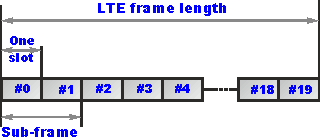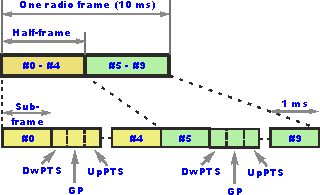LTE Frame & Subframe Structure: type 1 & type 2
LTE uses a frame structure of frames & subframes - type 1 & type 2 LTE frames - to provide the synchronisation and location for the data being carried.
4G LTE includes:
What is LTE
LTE OFDMA / SCFDMA
MIMO
LTE Duplex
LTE frame & subframe
LTE data channels
LTE frequency bands
LTE EARFCN
UE categories / classes
LTE-M (Machine to Machine)
LTE-LAA / LTE-U
VoLTE
SRVCC
LTE Advanced topics:
LTE Advanced introduction
Carrier aggregation
Coordinated multipoint
LTE relay
Device to device, D2D
Like previous cellular systems, and virtually all data communications systems, LTE data is carried in frames and subframes.
Using frames and subframes enables the data to be synchronised enabling the radio network to be able to handle the data correctly.
The frames and subframes used different between the FDD and TDD versions of LTE because there are different requirements for segregating data on the two schemes.
The two types of LTE frame structure are:
- Type 1: used for the LTE FDD mode systems.
- Type 2: used for the LTE TDD systems.
Type 1 LTE Frame Structure
The basic type 1 LTE frame has an overall length of 10 ms. This is then divided into a total of 20 individual slots. LTE Subframes then consist of two slots - in other words there are ten LTE subframes within a frame.

Type 2 LTE Frame Structure
The frame structure for the type 2 frames used on LTE TDD is somewhat different. The 10 ms frame comprises two half frames, each 5 ms long. The LTE half-frames are further split into five subframes, each 1ms long.

(shown for 5ms switch point periodicity).
The subframes may be divided into standard subframes of special subframes. The special subframes consist of three fields;
- DwPTS - Downlink Pilot Time Slot
- GP - Guard Period
- UpPTS - Uplink Pilot Time Stot.
These three fields are also used within TD-SCDMA and they have been carried over into LTE TDD (TD-LTE) and thereby help the upgrade path. The fields are individually configurable in terms of length, although the total length of all three together must be 1ms.
LTE TDD / TD-LTE subframe allocations
One of the advantages of using LTE TDD is that it is possible to dynamically change the up and downlink balance and characteristics to meet the load conditions. In order that this can be achieved in an ordered fashion, a number of standard configurations have been set within the LTE standards.
A total of seven up / downlink configurations have been set, and these use either 5 ms or 10 ms switch periodicities. In the case of the 5ms switch point periodicity, a special subframe exists in both half frames. In the case of the 10 ms periodicity, the special subframe exists in the first half frame only. It can be seen from the table below that the subframes 0 and 5 as well as DwPTS are always reserved for the downlink. It can also be seen that UpPTS and the subframe immediately following the special subframe are always reserved for the uplink transmission.
| Uplink / Downlink subframe configurations for LTE TDD (TD-LTE) |
|||||||||||
|---|---|---|---|---|---|---|---|---|---|---|---|
| Uplink-downlink configuration | Downlink to uplink switch periodicity | Subframe number | |||||||||
| 0 | 1 | 2 | 3 | 4 | 5 | 6 | 7 | 8 | 9 | ||
| 0 | 5 ms | D | S | U | U | U | D | S | U | U | U |
| 1 | 5 ms | D | S | U | U | D | D | S | U | U | D |
| 2 | 5 ms | D | S | U | D | D | D | S | U | D | D |
| 3 | 10 ms | D | S | U | U | U | D | D | D | D | D |
| 4 | 10 ms | D | S | U | U | D | D | D | D | D | D |
| 5 | 10 ms | D | S | U | D | D | D | D | D | D | D |
| 6 | 5 ms | D | S | U | U | U | D | S | U | U | D |
Where:
D is a subframe for downlink transmission
S is a "special" subframe used for a guard time
U is a subframe for uplink transmission
The frame and subframe structure used within LTE provides the data synchronisation and organisation required to enable it to be transferred in a logical and ordered fashion.
 Written by Ian Poole .
Written by Ian Poole .
Experienced electronics engineer and author.
Wireless & Wired Connectivity Topics:
Mobile Communications basics
2G GSM
3G UMTS
4G LTE
5G
Wi-Fi
Bluetooth
IEEE 802.15.4
DECT cordless phones
Networking fundamentals
What is the Cloud
Ethernet
Serial data
USB
LoRa
VoIP
SDN
NFV
SD-WAN
Return to Wireless & Wired Connectivity


